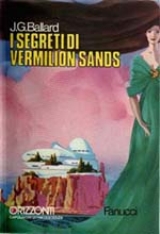
Vermilion Sands
Encyclopedia
Vermilion Sands is a short-story collection by J. G. Ballard
, first published in 1971. All the stories are set in an imaginary vacation resort called Vermilion Sands which suggests, among other places, Palm Springs in southern California. The characters are generally the wealthy and disaffected, or people who make a living off them, and parasites of various kinds.
In the preface, Ballard himself wrote: "Vermilion Sands has more than its full share of dreams and illusions, fears and fantasies, but the frame for them is less confining. I like to think, too, that it celebrates the neglected virtues of the glossy, lurid and bizarre."
Although the characters themselves often exhibit the same obsession, anomie and psychological disintegration typical of Ballard's characters, the emphasis on elaborate and sometimes humorously imagined art forms gives these stories a playfulness unusual in his other stories. A few other stories not set in Vermilion Sands are comparable because of their similar artistic games, especially "Sound-Sweep" (1960, on music/opera) and "Passport to Eternity" (1962, full of decadent trends and live fashions).
J. G. Ballard
James Graham Ballard was an English novelist, short story writer, and prominent member of the New Wave movement in science fiction...
, first published in 1971. All the stories are set in an imaginary vacation resort called Vermilion Sands which suggests, among other places, Palm Springs in southern California. The characters are generally the wealthy and disaffected, or people who make a living off them, and parasites of various kinds.
In the preface, Ballard himself wrote: "Vermilion Sands has more than its full share of dreams and illusions, fears and fantasies, but the frame for them is less confining. I like to think, too, that it celebrates the neglected virtues of the glossy, lurid and bizarre."
Stories
Vermilion Sands contains the following stories:- "Prima Belladonna" (1956)
- "The Thousand Dreams of Stellavista" (1962)
- "Cry Hope, Cry Fury!" (1966)
- "Venus SmilesVenus Smiles"Venus Smiles" is a short story by British author J. G. Ballard. Originally entitled "Mobile", it appeared in the June 1957 edition of Science Fantasy . It was then rewritten and appeared in the Vermilion Sands collection under its new name and later The Complete Short Stories of J. G...
" (1957) - "Studio 5, The StarsStudio 5, The Stars"Studio 5, The Stars" is a short story by British author J. G. Ballard, first appearing in the February 1961 edition of Science Fantasy ; it was reprinted in the anthology Billennium the following year. It later appeared in The Four-Dimensional Nightmare , Vermilion Sands and The Complete Short...
" (1961) - "The Cloud-Sculptors of Coral D" (1967)
- "Say Goodbye to the Wind" (1970)
- "The Screen Game" (1962)
- "The Singing Statues" (1962)
Exotic technology
Each story concentrates on different media - in some cases more than one - and most of them focus on a particular innovative, usually rather decadent/baroque twist on an existing artistic medium. For instance:- "Prima Belladonna" focuses on music, especially singing, via singing plants and a 'mutant' voice;
- "The Thousand Dreams of Stellavista" focuses on architecture, via mobile, mood-sensitive houses;
- "Cry Hope, Cry Fury" focuses on painting, through paints that respond to the presence of light/objects (an example of decadence through the evaporation of skill);
- "Venus Smiles" focuses on sculpture, through the creation of a (strangely growing) sound sculpture;
- "Studio 5, The Stars" focuses on poetry, through automated poetry machines (another example of skill vanishing, this time into automation);
- "The Cloud-Sculptors of Coral D" focuses on a peculiar kind of sculpture made by carving clouds - painting also appears in this one;
- "Say Goodbye to the Wind" focuses on fashion via living fashion and sound jewelry (non-aural music and erotic food are also mentioned in passing);
- "The Screen Game" has no unusual technologies, but an unusual aesthetic - jewels and screens dominate;
- "The Singing Statues" returns to sound sculpture (which may have been why it was removed from the American Berkley Medallion edition of 1971).
Although the characters themselves often exhibit the same obsession, anomie and psychological disintegration typical of Ballard's characters, the emphasis on elaborate and sometimes humorously imagined art forms gives these stories a playfulness unusual in his other stories. A few other stories not set in Vermilion Sands are comparable because of their similar artistic games, especially "Sound-Sweep" (1960, on music/opera) and "Passport to Eternity" (1962, full of decadent trends and live fashions).
Popular culture references
- The song "Vermillion Sands" on the Buggles album Adventures In Modern RecordingAdventures in Modern RecordingAdventures in Modern Recording is the second and last studio album by the British synthpop duo The Buggles released in 1981 on Carrere Records. Made one year after their stint as members of Yes, the album contains nine tracks, including a stripped-down version of Yes's "Into the Lens", here...
is probably referring to this collection. - A 1980s Japanese progressive rockProgressive rockProgressive rock is a subgenre of rock music that developed in the late 1960s and early 1970s as part of a "mostly British attempt to elevate rock music to new levels of artistic credibility." John Covach, in Contemporary Music Review, says that many thought it would not just "succeed the pop of...
band was called "Vermillion Sands". Their unique album featured a song entitled "The cloud-sculptors of Coral D". - Vermillion Sands is the name taken by a garage-pop band from Treviso, Italy.

